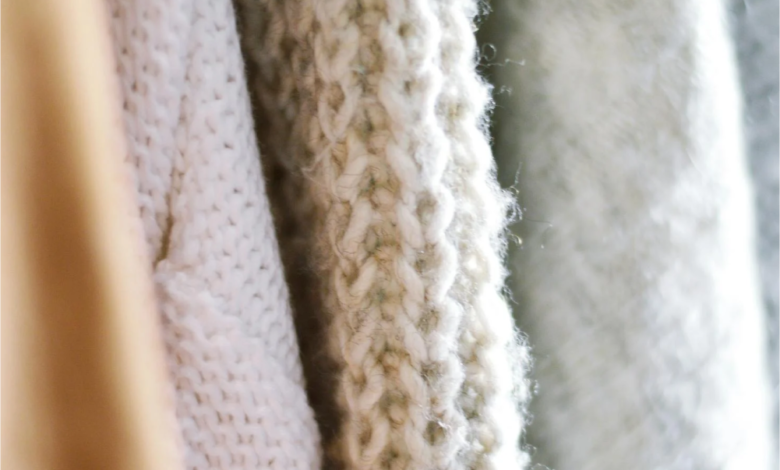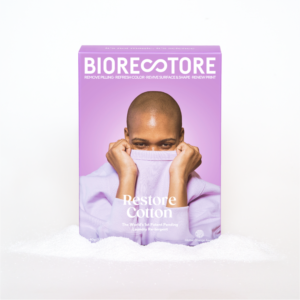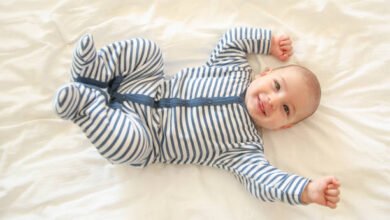What Fabrics Are The Mostly Susceptible to Pilling?

If you are wondering which fabrics in your wardrobe are the most and least prone to pilling, you are at the right place! There are hundreds of different textiles in the world, each with its own composition and structure. This is why their tendency to pill varies as well.
While it’s not possible to avoid pilling on clothes altogether, we will share some tips and tricks in this guide to help you make smart clothing decisions. Let’s get started!
What is pilling?
The small pesky balls of fibre clinging to the surface of your clothing are known as “pills” or “bobbles”. They are usually caused by friction due to rubbing against other fabrics and items (like your skin).
Fabric pilling is a natural process, and the hard truth is that you cannot avoid it forever. As you wear and wash your clothing, it will eventually face some stress. As a result, the fibres in the textile will break and tangle with each other, resulting in pilling.
Fabrics most prone to pilling
It’s true that pilling can appear on almost every type of fabric, however, some textiles, especially the knitted ones like cotton, wool, cashmere, acrylic, and polyester are extremely prone to it.
Synthetics
Fabrics containing synthetic (man-made) fibres like polyester, nylon, and acrylic are notorious for pilling. They have smooth surfaces and extremely low moisture absorption, which results in increased abrasion. Even after blending with natural fibres, their pilling susceptibility is much more than any other fabric.
To remove pills from clothes made of synthetic fibres, using a fabric shaver or “debobbler” is the best option. You can get an electric or a manual fabric shaver, depending on your needs and preferences. There are some great options available on the market, enabling you to switch between different blade heights and speed settings, according to the thickness and integrity of the garment.
Cotton and Cotton Blends
Cotton is a natural fabric generally blended with synthetic fibers like polyester or, elastane, to create affordable yet good-quality clothing.
Pilling on cotton blends can vary depending on the type of fibre and blend ratio. Typically, cotton-polyester, cotton-nylon, and cotton-acrylic blends are more prone to pilling than cotton-elastane, cotton-Lycra, and cotton-rayon blends.
Pure cotton or 100% cotton is exceptionally high-quality but can be more challenging to maintain as it can shrink or and fade when exposed to higher temperature in the washing machine or dryer Usually, long-staple or Supima cotton is more durable, (but also more expensive) pills less than shorter-staple or cheap-quality cotton clothing.
If cotton clothing has pilled. BIORESTORE cotton is an innovative way to remove pilling. The scientifically developed laundry solution form Sweden is a dedicated laundry powder for reviving your cotton clothing in the washing machine without any extra hassle.
Simply add your pilled cotton faves in the washing machine, add the recommended amount of BIORESTORE Re-Tergent, and run a cycle at 40ºC for 2 hours. Once the cycle is completed, toss the garments into the tumble drier. Plus, it’s extremely sustainable so you can add it to your laundry routine with no guilt.

Wool
Wool is another natural fabric, typically known for its warmth and comfort. The fabric can easily get lint and pilling, especially in the areas of high wear such as sweater cuffs, and underarms mostly due to the scaly nature of wool fibres.
Once again, you can use a fabric shaver to depill your woolen clothing. Lay the garment flat on a neat surface and ensure that it doesn’t have any wrinkles or creases. Start moving the shaver on the affected areas of the garment and use moderate pressure to remove the pilling.
Fabrics less prone to pilling
Silk
Silk is known for its smooth finishes and luxurious feel. It is made of long, continuous fibres with lower friction, making it highly resistant to pilling. But it doesn’t mean that your silk dresses won’t ever pill.
Use a fabric shaver with a fine blade or “gentle” setting to remove pilling from your silk clothing. A sweater comb can also be a good option as it is generally safe and protects your clothing from extra wear.
In case the pilling is severe, or you are unsure about the above-stated methods, it’s best to consult professional cleaning service providers rather than taking risks yourself.
Rayon
Rayon, a semi-synthetic fiber made from cellulose, has a slicker texture that can deter pilling. However, it can pill if subjected to rough washing and drying, as well as frequent friction.
For smaller pills, use a lint roller on the fabric. Lay the garment on a clean surface and move the roller on the affected areas. Once done, clean the lint roller and store it in a dry place. Make sure to not use adhesive rollers or sticky tapes on your rayon clothing as it can damage the garment.
If the pilling is more severe, use a fabric shaver specially designed for “delicate fabrics”. Make sure to stay cautious during the process as rayon is a delicate fabric and can easily be torn or damaged if excessive pressure is applied.
Linen
Linen- another natural fabric and one of my favourites is thankfully less prone to pilling. Its textile structure is extremely unique which makes the fibres long and they don’t break or tangle easily. Other than this, the fabric has a natural luster which further helps in resisting pilling.
However, if not properly taken care of, linen can pill a lot. To remove pilling on clothes made of linen, use a fabric shaver designed for “delicate fabrics”. Gently slide the shaver over the pilled areas, being extra careful not to cut into the linen fibers.
How to remove pills from clothes?
There are different pill removers available for different fabric types and pilling conditions. If your clothing is made of at least 70% cotton, use BIORESTORE Re-Tergent. This method is not only safe, but also extends the lifespan of your cotton clothing, keeping them fresh and vibrant for years to come.
If the fabric is made of synthetics, use a fabric shaver or “regular setting”. For delicate textiles such as silk, rayon, linen, and wool, make sure to pick a shaver that’s designed for “delicate fabrics”.
A manual lint remover can also be a great pill remover for fabrics with slight lint or pilling. When it comes to using home gadgets such as pumice stones, razors, and sticky tapes etc., unfortunately, they do more harm than good. So, unless you are a textile pro or have endless patience and a steady hand, I’ll recommend against using any of these options.




